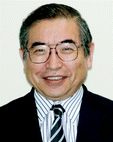DOI: 10.1039/C3CC90185H
(Profile)
Chem. Commun., 2013, 49, 7374-7375
Interview with Shunichi Fukuzumi
| ||||||
Do you remember what it felt like to publish your first ChemComm article?
My first ChemComm paper was published in 1985. In the same year I published a second ChemComm paper. At that time I was an assistant professor and these two papers helped me to be an independent researcher. I was very much impressed by the fast publication and the fair peer review system. In addition, the editorial English corrections were quite helpful for a Japanese person. ChemComm has been an excellent teacher for me to write papers in English. Since then ChemComm has become one of my most favourite journals to publish our exciting results. I have so far published 77 papers in ChemComm.How has your research evolved from your first to your most recent article?
The titles of my first two ChemComm papers in 1985 are “Six-coordinate high-spin iron(III) porphyrin complexes with NADH model compounds” (DOI: 10.1039/C39850001053) and “Acid catalysed reduction of aromatic aldehydes by an NADH model compound” (DOI: 10.1039/C39850001069) and both dealt with NADH analogues. The title of my most recent ChemComm paper in 2013 (77th paper in ChemComm) is “The long-lived electron transfer state of the 2-phenyl-4-(1-naphthyl)quinolinium ion incorporated into nanosized mesoporous silica–alumina acting as a robust photocatalyst in water” (DOI: 10.1039/C3CC41575A), dealing with an NAD+ analogue. Thus, I have continued exploiting redox and photochemistry of NADH/NAD+ analogues.What do you like most about publishing in ChemComm?
There are many points that I like publishing in ChemComm: (1) fast publication; (2) the fair peer review system; (3) a kind editing system for a non-native English speaker; (4) the high impact on the chemistry community; and (5) the concise and beautiful editing. The fast publication is especially nice, although I always feel strong pressure when I receive a reminder from the editor to review papers in ChemComm.What aspect of your research are you most excited about at the moment?
I have been most excited about application of our artificial photosynthetic systems for production of hydrogen peroxide as a solar fuel, which may be more useful than hydrogen. We have been developing a hydrogen peroxide fuel cell. The combination of the photocatalytic water oxidation by dioxygen to produce hydrogen peroxide as a solar fuel and a hydrogen peroxide fuel cell provides a promising perspective for an energy sustainable society.What is the best part of your job?
There are many opportunities when students find something unexpected, which looks impossible to explain by the common sense. When I figure out what is really going on by introducing a new concept, I feel really great. When the completion of one project results in creation of more than one new project, I enjoy seeing an explosion of new research in science. Taro Okamoto, a famous artist in Japan, used to say that art is an explosion! I hope that science is also an explosion! One example for me was the development of a simple artificial photosynthetic reaction centre model, which is capable of fast charge separation but slow charge recombination to afford a much higher energy and a much longer lifetime of the charge-separated state even compared to the natural system, leading to many applications.What is the secret to success in scientific publishing?
I have so far published nearly 900 papers. The most important thing in scientific findings is to first have deeply thoughtful research plans. Then we can start experiments to prove the ideas. However, it is also very important to re-evaluate original ideas whenever something unexpected takes place. This is the most exciting time when we are really stuck by experiments which seem to be completely contradictory to the original ideas. There should be really new concepts behind coming from such situations.What is your advice to young emerging scientists?
My supervisor used to say “Find out your lifetime subject to pursue in science”, which I have kept in my mind. It is quite important to find a subject that can very much excite you and then to pursue it during your whole life.What do you do in your spare time?
I can have spare time when I travel inside and outside Japan. During such trips, I read novels and history books. In particular history books are interesting to know how stories are so different depending on political philosophy or ideology. This always reminds me of Kurosawa's famous classic movie, “Rashomon”, in which a story becomes totally different depending on the person who is telling it. In science, there should not be any “Rashomon” stories, because the scientific truth must be the only one and it should not be contradictory.By the time I'm 100 I would like to…
… still be alive with good memories, figuring out how to unify many “Rashomon stories” in science and history. At the same time I would hope not to disturb young people by telling them outdated ideas. But I am afraid that I will not be able to help but do anything else.| This journal is © The Royal Society of Chemistry 2013 |

